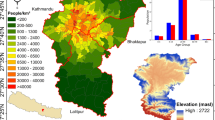Summary
This study investigates the characteristics of the daily maximum urban heat island (UHI) intensity in the six largest cities of South Korea (Seoul, Incheon, Daejeon, Daegu, Gwangju, and Busan) during the period 1973–2001. The annually-averaged daily maximum UHI intensity in all cities tends to increase with time, but the rate of increase differs. It is found that the average annual daily maximum UHI intensity tends to be smaller in coastal cities (Incheon and Busan) than in inland cities (Daejeon, Daegu, and Gwangju), even if a coastal city is larger than an inland city.
A spectral analysis shows a prominent diurnal cycle in the UHI intensity in all cities and a prominent annual cycle in coastal cities. A multiple linear regression analysis is undertaken in order to relate the daily maximum UHI intensity to the maximum UHI intensity on the previous day (PER), wind speed (WS), cloudiness (CL), and relative humidity (RH). In all cities, the PER variable is positively correlated with the daily maximum UHI intensity, while WS, CL, and RH variables are negatively correlated with it. The most important variable in all cities is PER, but the relative importance of the other three variables differs depending on city. The total variance explained by the multiple linear regression equation ranges from 29.9% in Daejeon to 44.7% in Seoul. A multidimensional scaling analysis performed with a correlation matrix obtained using the daily maximum UHI intensity data appears to distinguish three city groups. These groupings are closely connected with distances between cities. A multidimensional scaling analysis undertaken using the normalized regression coefficients obtained from the multiple linear regression analysis distinguishes three city groups. Notably, Incheon and Busan form one group, whose points in the two-dimensional space are very close. The results of a cluster analysis performed using the multivariate data of PER, WS, RH, and CL are consistent with those of the multidimensional scaling analysis. The analysis results in this study indicate that the characteristics of the UHI intensity in a coastal city are in several aspects different from those in an inland city.
Similar content being viewed by others
Author information
Authors and Affiliations
Rights and permissions
About this article
Cite this article
Kim, YH., Baik, JJ. Daily maximum urban heat island intensity in large cities of Korea. Theor Appl Climatol 79, 151–164 (2004). https://doi.org/10.1007/s00704-004-0070-7
Received:
Revised:
Accepted:
Published:
Issue Date:
DOI: https://doi.org/10.1007/s00704-004-0070-7




